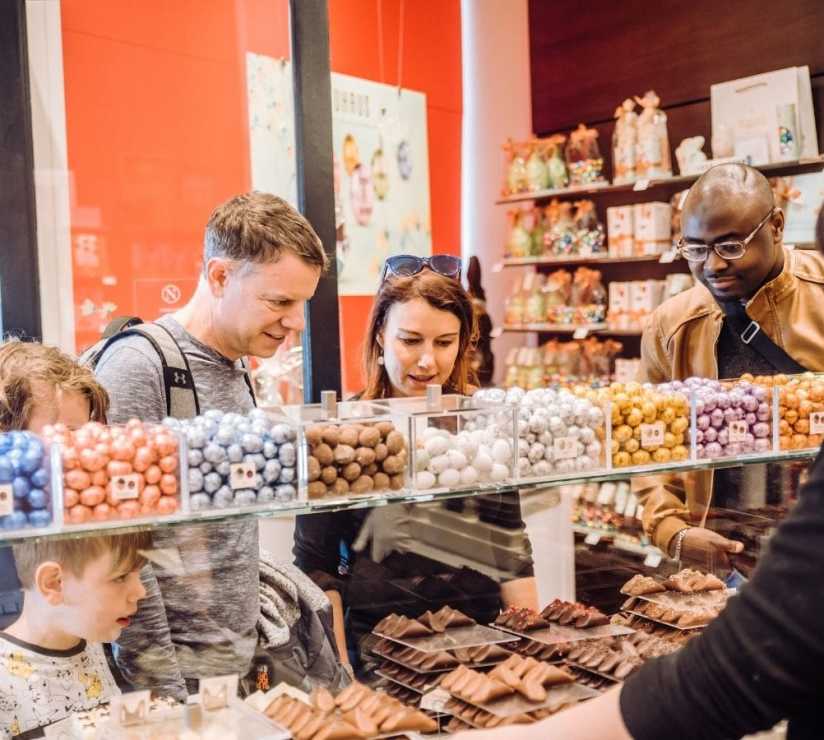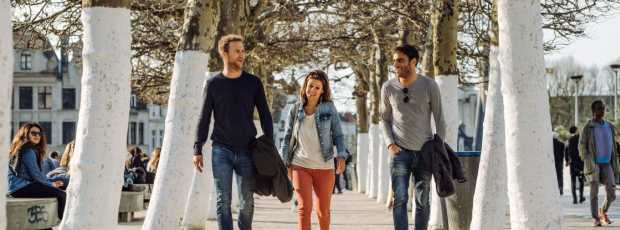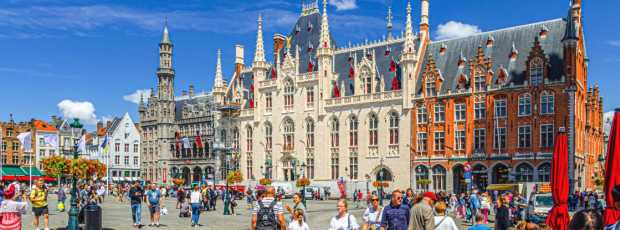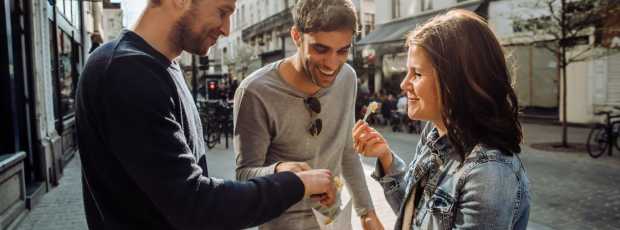Table Of Contents
- Why Most Brussels Activities Lists Get It Wrong
- What Makes Brussels Different from Other European Capitals?
- Is Grand Place Really Worth Your Time?
- How to Experience Art Nouveau Like a Local
- Where to Find Real Brussels Culture Beyond Tourist Zones
- What's Good About Brussels Museums?
- How Do You Navigate Brussels Neighborhoods?
- What About Food and Drink Activities?
- Are Brussels Tours Worth Taking?
- How to Make the Most of a Brussels Card?
- What Events and Festivals Should You Know About?
- Where Can You Find Shopping Experiences?
- How to Connect with Brussels' Creative Scene?
- Planning Your Brussels Activities: Practical Considerations
- Making Brussels Activities Work for Your Travel Style
![Hero image of a cyclist riding past a mural in Marolles, Brussels. Filename: brussels-street-mural.jpg]
Let me be honest about activities in Brussels: most guides will tell you to snap a photo of Manneken Pis and call it a day. That's like visiting Paris and only seeing the Eiffel Tower gift shop. I've lived here long enough to know that the real Brussels reveals itself when you venture beyond the predictable tourist circuit.
The capital of Belgium offers layers of complexity that most travelers miss entirely. Magritte's surreal imagination emerged from these very streets, and his murals are hidden throughout the communes. This place rewards curiosity. Chocolate tours can teach you something worthwhile, architectural masterpieces hiding in plain sight, Brussels activities range from the delightfully eccentric to the genuinely transformative.
Why Most Brussels Activities Lists Get It Wrong
The Brussels capital region deserves better than cookie-cutter recommendations. Too many guides treat this place like a day-trip destination, rushing people through the Grand Place before herding them onto tour buses.
Brussels isn't a museum piece frozen in the middle ages. It's a working metropolis where European Union diplomats grab morning coffee alongside comic book illustrators, where the royal museums sit blocks away from underground techno clubs.
What Makes Brussels Different from Other European Capitals?
Before diving into specific activities in Brussels, it's worth understanding what makes this place unique. Unlike London or Rome, Brussels doesn't overwhelm you with its greatness. Instead, it quietly goes about being fascinating.
The architecture alone tells multiple stories. Gothic town halls built in the middle ages stand alongside René Magritte's former studio neighborhood, where surrealist masterpieces took shape. Modern European Parliament buildings share space with 17th-century bread houses that once fed entire neighborhoods.
Todays houses blend traditional Belgian styles with contemporary European influences, creating streetscapes that feel both historic and vibrantly current.
Belgium's position at the crossroads of French and Dutch cultural influences created something entirely its own. You'll notice linguistic diversity in everything from street signs to café conversations, where locals effortlessly switch between languages depending on their audience.
Looking for a private city experience in Brussels?
Explore the city with a local who plans a private day just for you; no groups, no scripts.
Is Grand Place Really Worth Your Time?
Everyone mentions the Grand Place, so let me give you the local perspective. Yes, it's genuinely spectacular. Early morning reveals the square's true character. Local merchants set up at the bread house, and office workers cut through on their way to the European quarter.
Best Times to Experience Grand Place
Morning visits (8-9 AM) offer the square without crowds. The King's House (which never housed any Belgian royal family members) contains the Brussels City Museum, offering context that transforms the square from a pretty backdrop into a meaningful historical site.
Key Grand Place insights:
- Best time: Early morning or late evening after crowds disperse
- Hidden details: Look up at the guild house symbols telling trade stories
- Local tip: The bread house still operates – grab pastries from the source
How to Experience Art Nouveau Like a Local
Here's where Brussels truly distinguishes itself from other European capitals. This place contains the world's largest concentration of architectural innovation, but most people only see the obvious examples.
Start in Ixelles, where Victor Horta's innovations changed how people thought about domestic space. His house and studio (now a museum) demonstrate how this style wasn't just decoration – it was a complete reimagining of modern living.
Hidden Architectural Gems
Wander through residential streets between Place Eugène Flagey and Avenue Louise. Every block contains examples of how local architects interpreted these principles. The Saint-Gilles commune offers particularly rich hunting grounds where middle-class families commissioned houses that balanced innovation with practicality.
Strategy:
- Start at: Horta Museum for foundational understanding
- Continue to: Residential streets in Saint-Gilles for authentic examples
- Look for: Integration of ironwork, glass, and stone in single compositions
Where to Find Real Brussels Culture Beyond Tourist Zones
The European quarter gets dismissed as sterile office buildings, but that misses the cultural ecosystem that's developed around EU institutions. Small galleries showcase contemporary European works, while jazz clubs host musicians from across the continent.
My favorite discovery zone remains the Marolles district, where antique dealers and experimental galleries create an atmosphere you won't find anywhere else. The daily flea market at Place du Jeu de Balle reveals Brussels' relationship with objects and history.
Comics and Theatre Scene
Belgium birthed Tintin and the Smurfs, but the comics scene continues to evolve. The Comics Art Museum near Central Station provides comprehensive context for understanding how this country became Europe's comic book capital, with exhibits tracing the evolution from early newspaper strips to contemporary graphic novels.
Theatre enthusiasts should explore beyond the grand Théâtre Royal de la Monnaie to smaller venues presenting multilingual productions. Many cultural associations throughout the region organize experimental performances that blend French and Flemish dialogue, reflecting Brussels' unique linguistic landscape.
What if your day in Brussels was planned by someone who knows it — and you?
City Unscripted matches you with a local host who creates a private experience based on your interests, not a set route.
What's Good About Brussels Museums?
The Royal Museums of Fine Arts contain genuine treasures, often overshadowed by more famous European collections. The Flemish primitive paintings here influenced Renaissance styles across the continent. The modern collections include works by Belgian surrealists like René Magritte, who challenged how people understood reality through his thought-provoking visual paradoxes.
My recommendation focuses on smaller, more focused institutions. The Musical Instruments Museum occupies a stunning building and tells stories about how different cultures approach sound and rhythm. The Comics Museum succeeds because it takes its subject seriously without being academic.
Don't overlook the quirky specialized museums. The Beer Museum near Grand Place explains how brewing techniques shaped Belgian culture, while the Chocolate Museum provides context for understanding why Belgian chocolates earned their reputation.
Museum strategy for culture lovers:
- Morning focus: One major museum when you're mentally fresh
- Afternoon choice: Specialized museum matching your interests
- Local tip: Many museums offer late hours one evening per week
How Do You Navigate Brussels Neighborhoods?
The center around Grand Place provides an obvious starting point, but venture into Sablon for antique shops and chocolate boutiques.
Ixelles attracts younger crowds with vintage shopping and university energy. The pond area offers green space between cultural explorations, while surrounding streets contain excellent examples of domestic architecture from the nouveau period.
Neighborhood Character Guide
Saint-Gilles combines residential charm with cultural edge, featuring concert venues and experimental galleries. The European quarter offers Leopold Park's tranquility plus restaurants serving cuisine from every EU member state.
Navigation tips:
- Transport: Single metro day pass covers most cultural districts
- Local insight: Brussels locals mix neighborhoods throughout their days
What About Food and Drink Activities?
Belgian beer deserves its reputation, but approaching it like a tourist checklist misses the cultural significance. Beer cafes reflect the neighborhood's character and the owner's personal selection philosophy.
Chocolate tours vary enormously in quality. The best ones explain how Belgian chocolate-making techniques developed and why specific cocoa beans work better for different preparations.
Traditional Brussels cuisine extends far beyond waffles and frites, though both deserve respect when prepared properly. Look for restaurants serving waterzooi, a creamy stew that originated in nearby Ghent. Where to eat becomes a cultural exploration itself, the emerging food scene reflects Brussels' international population, with Ethiopian restaurants in Matonge serving authentic African cuisine, while Vietnamese establishments near Midi station continue traditions established by earlier immigration waves from this former colonial country.
Tip
We match you with the right host, not just any guide.Want to experience the real Brussels with someone who lives there?
A fully private experience, planned and led by a local host who tailors the day to you
Are Brussels Tours Worth Taking?
Most organized tours in Brussels follow predictable routes designed for efficiency rather than insight. However, certain specialized tours offer genuine value by focusing on specific themes or providing access to otherwise closed spaces.
Architecture tours led by local experts can reveal details about nouveau and other Brussels styles that you'd miss exploring independently. These guides understand how different building periods relate to each other.
Food-focused experiences work best when they combine tastings with cultural education. The most valuable chocolate tours explain production techniques and ingredient sourcing, while beer tours connected with local brewing associations provide authentic insights into Belgian brewing culture rather than simple consumption experiences.
Instead of generic tours, consider Brussels experiences that connect you with locals who share their authentic perspectives on metropolitan life.
Choosing Quality Tours
Walking tours succeed when they focus on neighborhoods rather than trying to cover everything. A good Marolles tour reveals how this working-class area maintained its character despite gentrification pressures.
Selection criteria:
- Specialization: Choose focused themes over general overviews
- Group size: Smaller groups allow for personalization and questions
How to Make the Most of a Brussels Card?
The Brussels Card provides access to numerous museums and attractions, plus public transportation, but its value depends entirely on strategic use. The card works best when you focus on higher-priced attractions that align with your interests.
Brussels Card optimization:
- Day one: Focus on major museums when energy levels are highest
- Transportation: Factor metro/tram costs into value calculations
What Events and Festivals Should You Know About?
Brussels' cultural calendar extends far beyond the famous Ommegang pageant. Year-round festivals reflect both traditional Belgian culture and contemporary international influences, often organized by cultural associations that preserve this country's diverse heritage.
Music festivals throughout the Brussels capital region range from classical concerts in historic venues to electronic music events in converted industrial spaces. Summer brings outdoor events combining multiple forms; music, visual works, food, and performance. Many events feature programming in both French and Flemish, reflecting the region's bilingual character.
Ready to plan your perfect day in Brussels?
Start your experienceWhere Can You Find Shopping Experiences?
Shopping in Brussels extends far beyond predictable souvenir shops. The retail landscape reflects cultural diversity and traditions, offering items that connect to genuine local creativity.
Antique hunting in the Sablon area reveals how Brussels accumulated objects from across its trading history. Independent bookshops stock publications in multiple languages, including works in French and Flemish that reflect this country's unique bilingual literary tradition. Comic book specialists carry both classic Belgian series and contemporary international publications, with many shops maintaining close relationships with local artists' associations.
Fashion shopping divides between established boutiques and experimental designers who often collaborate with cultural associations to showcase emerging talent from across Europe.
Authentic shopping areas:
- Antiques: Sablon for quality, Marolles for variety and adventure
- Fashion: Mix established boutiques with emerging designer areas supported by local creative associations
How to Connect with Brussels' Creative Scene?
Brussels attracts creative professionals from across Europe, creating an ecosystem that's both internationally connected and distinctly local. Galleries throughout the region showcase both established and emerging talent, with many hosting opening events that provide opportunities to meet professionals and collectors.
Music venues range from jazz clubs that have operated for decades to experimental spaces hosting avant-garde performances. Design studios sometimes offer classes for people interested in learning about Belgian approaches to craftsmanship.
Creative Community Access
Engagement opportunities:
- Gallery openings: Usually Thursday evenings, open to public
- Music venues: Check smaller clubs for adventurous programming
- Workshops: Advance booking usually required for hands-on experiences
Planning Your Brussels Activities: Practical Considerations
Successful Brussels experiences require understanding how the region operates rather than imposing external expectations about European capitals.
Many museums close on Mondays, while some extend hours on specific weekdays. Planning around these schedules helps you avoid disappointment and allows you to match your energy levels with appropriate activities. Morning museum experiences often provide better encounters due to smaller crowds.
Brussels weather influences outdoor activities significantly. The area experiences frequent light rain, making indoor cultural options valuable backup plans.
Transportation within the Brussels capital region works efficiently once you understand the system. Metro, tram, and bus connections allow you to move between neighborhoods without detailed advance planning. Most cultural areas remain accessible by public transit.
Restaurant timing follows Belgian rather than international tourist schedules. Lunch service often ends earlier than people expect, while dinner service begins later. Planning meals around these local customs prevents disappointment and improves your dining experiences.
For comprehensive guidance on navigating these practical considerations, consult our detailed Brussels travel tips that locals actually use.
Practical planning priorities:
- Museum schedules: Check Monday closures and extended evening hours
- Weather backup plans: Indoor cultural options for Brussels' frequent drizzle
- Local dining times: Respect Belgian meal schedules for better service
Making Brussels Activities Work for Your Travel Style
Brussels accommodates different travel approaches better than places that demand specific tourist behaviors. Cultural enthusiasts can spend days exploring Brussels' heritage without exhausting the available options.
Food and drink focus works particularly well due to the compact size and neighborhood diversity. Architecture enthusiasts find Brussels endlessly rewarding, with multiple periods and styles within small areas.
Casual travelers who prefer mixing planned activities with spontaneous discovery will find Brussels accommodating. Major attractions cluster in walkable areas, while neighborhood exploration reveals surprises that can't be predetermined.
Brussels reveals itself to people who approach the region with curiosity rather than predetermined expectations. The best activities in Brussels happen when you understand the local rhythms and cultural layers, allowing authentic experiences to develop naturally rather than forcing tourist encounters.
From architectural masterpieces that influenced European design to chocolate workshops that explain Belgian craftsmanship traditions, Brussels offers reward those who seek depth over superficial attractions. The capital's position as European headquarters adds contemporary relevance to historical foundations, creating cultural experiences that feel both rooted and dynamic.
Whether you're drawn to fine pieces in world-class museums, experimental music in intimate venues, or simply want to understand how Belgian beer culture shapes social life, Brussels provides authentic encounters that connect you with broader European cultural currents. The key lies in choosing activities that match your interests while remaining open to the discoveries that make travel memorable.
Brussels activities summary: Focus on authentic cultural experiences over tourist attractions, explore diverse neighborhoods rather than staying in the center, and engage with local rhythms rather than imposing external schedules for the most rewarding Brussels experience.
What if your day in Brussels was planned by someone who knows it — and you?
City Unscripted matches you with a local host who creates a private experience based on your interests, not a set route.
Want to experience the real Brussels with someone who lives there?
A fully private experience, planned and led by a local host who tailors the day to you











